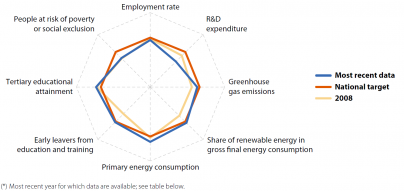Archive:Europe 2020 indicators - Finland
- Data from June 2017. Most recent data: Further Eurostat information, Main tables. Planned article update: September 2018.
This article is part of a set of statistical articles on Europe 2020 strategy, focusing on the situation in Finland.

Source: Eurostat (see dedicated web section: Europe 2020 headline indicators)
Explanations on this radar chart are available here.
Main statistical findings

Source: Eurostat (see dedicated web section: Europe 2020 headline indicators)
With 46.1 % of the population aged 30 to 34 having completed tertiary education in 2016, Finland continued to exceed its national target of 42 %. However, its target is defined more narrowly than the EU target as it excludes former tertiary Vocational Education and Training (VET). In the same year, the country also reached its target on early leavers from education and training. With a share of renewable energy in final energy consumption of 39.3 %, Finland exceeded its national 2020 commitment by 1.3 percentage points in 2015. The country’s primary energy consumption amounted to 32 Mtoe in 2015, which was below the respective national target of 35.9 Mtoe. As a result of the continuous decrease in R&D expenditure as a share of GDP since 2009, Finalnd lost its leading position in terms of R&D intensity and moved away from its very ambitious national target. Finland’s employment rate fell from 75.8 % in 2008 to 73.4 % in 2016, increasing the distance to its national target of 78 %. Despite a notable 8.4 percentage point reduction in GHG emissions in non-ETS sectors between 1990 and 2015, the gap to the national target remained larger than in most other EU countries. The country would also need to lift 134 000 more people out of the risk of poverty and social exclusion to meet its 2020 commitment.
Data sources and availability
More information about the origin of the data and the calculation of indicators can be obtained via the Europe 2020 indicators dedicated website.
Under 'Main tables', click on the icons next to the indicators:
- 'Explanatory texts (metadata)' for a detailed overview of the collection and compilation methods;
- 'Information on the leaf' for data availability per country.
A more general overview of quality procedures can be found in Implementation of standard reference metadata for indicators - the ESMS Indicator Profile (ESMS-IP) (PDF file).
Context
Europe 2020 is the EU’s agenda for jobs and growth for the current decade. It emphasises smart, sustainable and inclusive growth as a way to strengthen the EU economy and prepare its structure for the challenges of the next decade. As a main objective, the strategy strives to deliver high levels of employment, productivity and social cohesion in the Member States, while reducing the impact on the natural environment.
See also
Further Eurostat information
Publications
- Smarter, greener, more inclusive - indicators to support the Europe 2020 strategy (online publication, also downloadable as PDF file
Main tables
Dedicated section
Methodology / Metadata
- Towards robust quality management for European Statistics - Communication from the Commission to the European Parliament and the Council COM(2011) 211 final.
Other information
- Regulation (EC) No 223/2009 of 11 March 2009 on European statistics